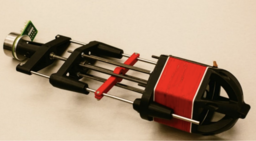Variable Stiffness Actuator with Electrically Modulated Stiffness
TECHNOLOGY NUMBER: 2020-447

OVERVIEW
A variable stiffness actuator (VSA) than can modulate its stiffness to improve powered ankle-foot orthoses- Use of dielectric elastomer system (DES) to eliminate the need for a second motor to modulate stiffness
- The resulting PAFO actuator increases portability and therefore optimizes user compliance
BACKGROUND
Powered Ankle-Foot Orthoses (PAFOs) provide walking assistance to people with neuromuscular impairments. Because these robotic devices integrate closely with humans in the fundamental task of locomotion, they should be both portable and compliant. Series Elastic Actuators (SEA), consisting of a conventional actuator connected in series through an elastic element to a load, offer several benefits for PAFOs. First, they provide a safer human-machine interface than rigid PAFO actuators do because the actuated joint is back-driveable and capable of shock absorption. Second, expensive load cells are not needed to measure SEA output force. Also, SEA output force can be calculated from measurement of the contraction or extension of its elastic element, reducing the cost for closed-loop force control. Finally, SEA can weigh less than rigid PAFO actuators with the same peak power output capability.
Since walking is a cyclic process, the SEA elastic element can absorb energy in one part of the cycle and then release it later, reducing the peak power required from the SEA motor. Because of this power reduction, a PAFO SEA can use a smaller, lighter motor than a rigid PAFO actuator requires resulting in overall weight savings. The optimal stiffness value for a PAFO SEA's elastic element (resulting in minimal actuator weight) depends on the task the PAFO user is performing (e.g., running, slow/fast walking, or stair climbing/descent) as well as the user's weight and personal gait pattern. These parameters can change during normal operation of a PAFO, so a fixed stiffness elastic element cannot always provide optimal peak power reduction. An SEA with a poorly chosen stiffness may have higher motor peak power requirements than a rigid actuator and thus demand a heavier motor than necessary. Therefore, a need exists for a Variable Stiffness Actuator (VAS) to optimize the effects of PAFO.
INNOVATION
Researchers have invented a Variable Stiffness Actuator (VSA) that is mechanically simple, free of rolling or sliding parts, allows stiffness changes while loaded, and improves significantly upon existing designs. This novel approach utilizes a dielectric elastomer system (DES) in the VSA's variable stiffness mechanism, yielding an architecture which eliminates the need for a second motor to modulate stiffness. DE are flexible polymers coated with flexible electrodes that expand when energized with electrical charges. The advantages of this invention over existing VSA designs are manifold: 1) the VSA may weigh less since it does not require a motor for stiffness modulation; 2) the VSA can change stiffness rapidly enabling modulation of its stiffness during operation; 3) the DE could regenerate energy during operation; 4) DE can work as strain and force sensors; and 5) the PAFO can be more comfortable to wear since DE can be formed into shapes that conform to the user’s body. This design permits changes in the electrical field on the DES to modulate the stiffness of the actuator. As such, this form of VSA softens when energized and is thus "default-stiff," which is beneficial for applications requiring rigid, unpowered behavior such as exists in many robotic prosthetic legs. Experimental results indicate the viability of this approach for modulating stiffness and verify that the actuator generates forces meaningful for gait assistance.